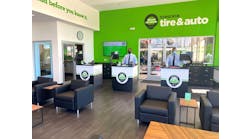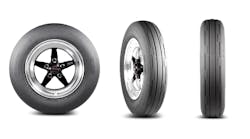This MTD exclusive was provided by tire industry veteran Jeff Morgan, executive director of Dealer Strategic Planning, the DSP Group.
One thing that is not debatable is the speed of change today. It is simply getting faster and faster. Think about it. The modes of transportation for humans had not changed in thousands of years and then came the locomotive. Just over 150 years after the first locomotive, we traveled to and landed on the moon.
In a more current example, less than 25 years ago, most people only had landline home phones. Now, nearly every family member older than 12 years of age has a cell phone.
Even the capabilities of cell phones 10 years ago were not close to what they can do today. Change is inevitable and technology is driving much of the change we are seeing. We must embrace it and prepare for it.
In our industry, we are faced with technological changes in nearly every aspect of what we do. Automotive systems are evolving and changing. How we interact with our customers is evolving and changing. Waves of change are hitting us from both sides.
It is important to recognize these changes and act upon them at the right time in order to keep our businesses thriving.
First, let’s consider vehicles. One technological change that is continuing to evolve is that of hybrid and electric vehicles. Some studies seem to indicate that internal combustion engines will continue to far exceed the number of electric vehicles you will see over the next few years.
However, that does not mean that you should become complacent. Do not think for a minute that the wave of electric vehicles isn’t coming, because it is.
Whether you catch and ride the wave forward - or get crushed underneath it - is up to you.
Now is the time to start developing your dealership to service these vehicles. It starts with having the right people to do the job.
I realize that this might seem like a “chicken or egg” choice, but I believe that investing in equipment and tools to do this work without having the right people who can do the work is a waste of cash.
If you do not have someone capable now, you need to be looking at who you can train and develop to do the work or bite the bullet and hire someone who can.
Neither option will come cheap. This is something you need to look at as an investment instead of an expense.
Granted, many of you are already servicing hybrid vehicles today. However, this technology is ever-evolving too. It is important to stay current on different procedures and safety protocols with the various hybrid vehicles that are out there.
All-electric vehicles are a different story. Not only is training on how to work on these vehicles somewhat scarce, but other nuances come into play. For example, electric vehicles generate less noise than gas-powered vehicles, so tires for electric vehicles need to produce less noise, too. This can complicate otherwise simple tire replacement and repair.
Understanding all this is involved with electric and hybrid vehicles, particularly as the available vehicle choices expand, is required to ensure you are doing things right.
One vehicle technology that is definitely in the here and now is ADAS (Advanced Driver Assistance Systems.)
These systems control things like cruise control distance, automatic braking assistance, lane alert systems and others. Being able to calibrate ADAS is very important, particularly if working on things that could affect them, such as alignments, ride height changes or windshield replacements.
Servicing and calibrating ADAS can be a revenue generator for your dealership. It also can present some challenges.
The first issue is the obvious one of having to send the customer to someone else to service their vehicle’s ADAS if your dealership is incapable of doing so. Any time you send your customer to a car dealership or another competitor, you run the risk of losing that person’s business in the future.
There could be another issue that is more of a technical nature, when it comes to ADAS.
If you align a vehicle along the thrust angle, it will track down the road to some degree off of the geometric center. However, the ADAS will still be aligned to the geometric center. This could cause the system to not work properly since it is not “looking” in the same direction that the vehicle is actually headed.
Drivers are becoming very reliant on ADAS. If their vehicle’s ADAS is not working properly, it could cause a potential accident, for which you could be liable.
While many vehicle original equipment manufacturers’ programs require a large space and specialized equipment, the aftermarket is rapidly developing equipment that is more inclusive and easier to incorporate in your service bays.
This creates a much better opportunity for you to begin performing these services, where the restrictive nature of older equipment perhaps kept you out.
The time is now to get involved with ADAS because more vehicles equipped with ADAS are headed your way.
The intersection of technology and customer interaction is always evolving, too. You are probably finding yourself communicating less with customers verbally and more electronically. This is just a reflection of society, in general. As such, we need to be conscious of what the customer wants and meet them there.
Two technology-driven services I want to call out may be offered at your dealership now. If they aren’t, I would suggest you strongly consider offering them. One is digital vehicle inspection and the other is text-to-pay.
Digital inspections have been around for awhile now. They allow you to share photos or videos of vehicle conditions or the results of an inspection with the customer electronically.
With the COVID-19 pandemic forcing more people to limit their personal interactions, this process became a huge advantage when it came to selling additional work.
The old routine of "show and tell" no longer requires you to take the customer out to their car. You can show what you have found, explain what should be done and offer to perform this service - all while the customer is comfortably sitting at home.
Some of you have this technology in your stores. But are you using it correctly and leveraging the tool properly? I have seen some dealerships that have invested in this technology, only to rarely use it because their inspection process is poor. As with any tool, a digital inspection is only as good as how you use it. If you are not using this tool, you are going to be left behind by the competition.
Even as stay-at-home restrictions loosen around the country, the conveniences that most customers have become accustomed to are still going to be in demand.
Being able to pay from their personal device is one of those things. Not having to hand over cash or pull out a credit card is becoming more and more preferred. Additionally, paying electronically from home gives customers more flexibility and convenience as to when they choose to pick up their car.
Having text-to-pay or other digital payment options meets these new convenience demands that are here to stay.
With most of the technological advancements that are impacting your business, the question is not if you make the investment, but when. There are two very important questions that you need to ask in making that determination:
1. What is the benefit to my business if I invest in this technology now?
2. What is the risk to my business if I do not?
If the answer to both of these questions is "minimal," perhaps this is something that you can kick down the road a bit, to re-examine at a later date. If the answer is "significant," you need to look at making the investment as soon as possible.
Determine your total investment of equipment, tools, training and people and then do what you must to get going.
You may feel that you are not in a cash position to move forward right now and that makes sense. However, will your cash position get worse if you are not evolving your business to the next level?
Finding that right time is never an easy thing. It’s always a delicate balance. However, putting it off too long could leave you beneath the wave, struggling to stay afloat.
Tire industry veteran Jeff Morgan is the executive director of Dealer Strategic Planning, the DSP Group. He can be reached at [email protected] or (651) 846-9871. For more information, see www.20DSP.com.




